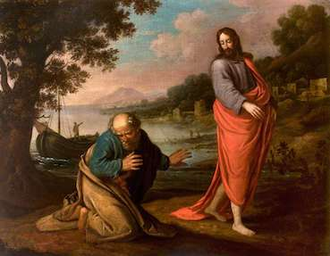Gospel in Art: Jesus rebuked Peter

Christ rebuking Peter, Flemish School, 1600, © National Trust, Kingston Lacy, Wimborne Minster
Source: Christian Art
Gospel of 15 September 2024
Mark 8:27-35
Jesus and his disciples left for the villages round Caesarea Philippi. On the way he put this question to his disciples, 'Who do people say I am?' And they told him. 'John the Baptist,' they said 'others Elijah; others again, one of the prophets.' 'But you,' he asked 'who do you say I am?' Peter spoke up and said to him, 'You are the Christ.' And he gave them strict orders not to tell anyone about him.
And he began to teach them that the Son of Man was destined to suffer grievously, to be rejected by the elders and the chief priests and the scribes, and to be put to death, and after three days to rise again; and he said all this quite openly. Then, taking him aside, Peter started to remonstrate with him. But, turning and seeing his disciples, he rebuked Peter and said to him, 'Get behind me, Satan! Because the way you think is not God's way but man's.'
He called the people and his disciples to him and said, 'If anyone wants to be a follower of mine, let him renounce himself and take up his cross and follow me. For anyone who wants to save his life will lose it; but anyone who loses his life for my sake, and for the sake of the gospel, will save it.'
Reflection on the painting
We often hear the phrase, "actions speak louder than words." It is commonly believed that what people do reveals more about their true nature than what they say. If someone's actions contradict their words, it is their actions that ultimately shape our view of them. However, today's gospel reading suggests that, for Jesus, words and the intentions behind them are also crucial in evaluating the depth of our relationship with God. Actions are important, but so are words. What we say and what we do need to be in perfect tune with one another.
When Jesus asked his disciples, "Who do you say that I am?" Peter answered on behalf of everyone, declaring, "You are the Messiah." On one level, Peter's words were appropriate; Jesus was indeed the long-awaited Jewish Messiah. Yet, on another level, Peter's understanding of those words was completely different from Jesus' own understanding. When Jesus revealed that, as the Messiah, he would also be the suffering and rejected Son of Man, Peter rebuked him. This was not the kind of Messiah Peter envisioned at all; he did not see himself as a follower of a crucified Messiah. But Jesus teaches that staying true to God's calling and participating in God's work often involves walking the path of the cross. He instructed his followers that they must be prepared to choose this path if staying faithful to God's values, as revealed by Jesus, demands it. Peter's words were right, and his actions too, but the feelings behind them weren't. Jesus wanted to align everything, so that what Peter spoke, what he did, how he thought, would all be perfectly aligned.
Our painting by an anonymous Flemish painter, circa 1600, shows Peter, who has dropped to his knees, his gaze lowered in shame. His left hand is extended towards Christ, almost pushing Christ away, a gesture that indicates he is not feeling worthy to be in the company of his master. Peter's right hand rests on his chest in remorse. Christ is moving to the right but has turned his head to look at the disciple. He wouldn't leave Peter, of course, but a rebuke was needed. Jesus devoted considerable time and energy to teaching his disciples, sometimes even causing difficult moments. The scene is set by a lakeside, where a masted ship is visible, a reminder of Peter's old life as a fisherman.
LINKS
Gospel in Art: https://christian.art/
Today's Reflection: https://christian.art/daily-gospel-reading/mark-8-27-35-2024/


















